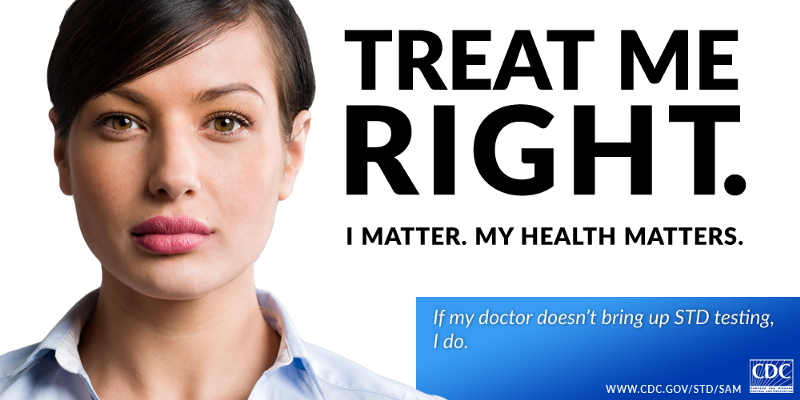New study on STIs shows we’re failing young people.
 By Zach Eisenstein, Communications Manager
By Zach Eisenstein, Communications Manager
Across the country, sexual health professionals and advocates are bringing their STD Awareness Month activities to a close. This year, many are pointing to a study that asked young women (ages 15–24) about their perceptions of sexual health and sexually transmitted infections (STIs). The study, conducted by Quest Diagnostics in December 2017, found the following:
- Nearly half of young women (44%) have never been tested.
- Only 39% say their partners used a condom the last time they had sex
- Nearly 90% don’t think they are vulnerable for chlamydia or gonorrhea
These findings, coupled with the frequently cited fact that nearly half of all STIs diagnosed each year are among young people, indicates a big problem:
When it comes to STI treatment and prevention among young people, we’re failing. And we need to change the way we communicate about STIs…yesterday.
How can we do this? Here are five tips to consider during #STDMonth18:
1. Change the language: Use STIs, not STDs.
If you’re using the terms STD (sexually transmitted disease) and STI (sexually transmitted infection) interchangeably, you’re not wrong. Many organizations and individuals use and accept both. That said, there’s an important difference: infections are only called diseases when there are symptoms. Because many STIs show zero symptoms, using the term “STI” is more accurate. This is also helpful in the never-ending quest to encourage folks to get tested, reminding them that the only way to be sure if you have an STI or not is to take a test.
Aside from the technical aspect, “STI” is increasing in popularity as a way to tackle stigma. Spoiler: stigma is a huge barrier that gets in the way of learning about, talking about, and getting tested for STIs. Using “STI” helps reduce stigma by moving away from the “life-ending, disastrous” disease, and toward the more realistic preventable, treatable, and manageable infection.
The latest data tells us that scare tactics don’t scare people away from having safer sex. Rather, they scare people away from getting tested.
2. Accept the plain fact: These are common (especially among young people).
The Centers for Disease Control and Prevention estimate that there are nearly 20 million new infections every year in the U.S. alone — and half of them are among people ages 15–24.
These statistics might seem overwhelming. But, what’s important to note here is that STIs affect a lot of people. Having an STI does not reflect your character, your cleanliness, or say anything about you as a person, whatsoever.
STIs happen. And they need to be addressed like any other prevalent health-related issue. It’s absurd to think that so few people are getting tested for STIs simply because they’re associated with the word “sex.”
3. Talk about STIs with your partner.
While discussing STIs with your partner should be simple, in reality, this is much easier said than done. Why? Because, as a society, we have a funny way of shaming any and everything related to sex or sexuality. But there are plenty of resources to help tackle this subject in a way that works for you. Check out these videos from our partner, Planned Parenthood, for examples of conversations you can have with your partner.
4. Talk about STIs with your health care provider.
Not only do people struggle with talking about STIs and testing, but there is also a LOT of information out there. What STIs should you be tested for? How do you make sure you get what you need? What if you’re afraid of asking your doctor? Luckily, there are also lots of resources available to help streamline that conversation. Check out these suggestions from Verywell Health. And make sure you remember two important things:
1. STI screenings are (and should be) treated like all other non-sex-related preventative health care.
2. The doctor-patient relationship means that anything you discuss with your doctor is confidential.
5. Advocate for sex ed that presents the facts, shame-free.
Last but certainly not least, one of the most powerful tools for prevention is education. In too many classrooms across the country, young people are not learning the age-appropriate, accurate, affirming information about sex and sexuality that they need to stay safe and healthy.
No matter how, why, or at what age young people engage in sexual activity, they should have the information they need to prevent STIs. Period.
While understanding and preventing STIs is only a small part of a much larger, more holistic sex education, it’s a vital one.
Unsure about the state of sex ed in your community? Find out today. If your community isn’t doing enough to provide young people with the information they need to make the decisions that are best for their health and wellbeing, take action. Make noise. And don’t quiet down until young people in your community get the sex education they deserve.
The CDC’s theme for STD Awareness Month 2018 is “Treat Me Right.” This year, they’re focusing on the doctor-patient relationship — providing resources for patients and doctors to build trust and work together to combat rising STI rates.
While this focus is critical, at SIECUS, we think “Treat Me Right” extends far beyond the doctor-patient relationship. Everyone deserves to be treated with dignity and respect in regard to their sexuality no matter their age, identity, or STI status.
And that’s something we should work toward today, tomorrow, and long after the STI awareness activities wrap up come May.
Sign Up for Email Updates
Interested in receiving the latest updates from SIECUS? Join our email list today.

